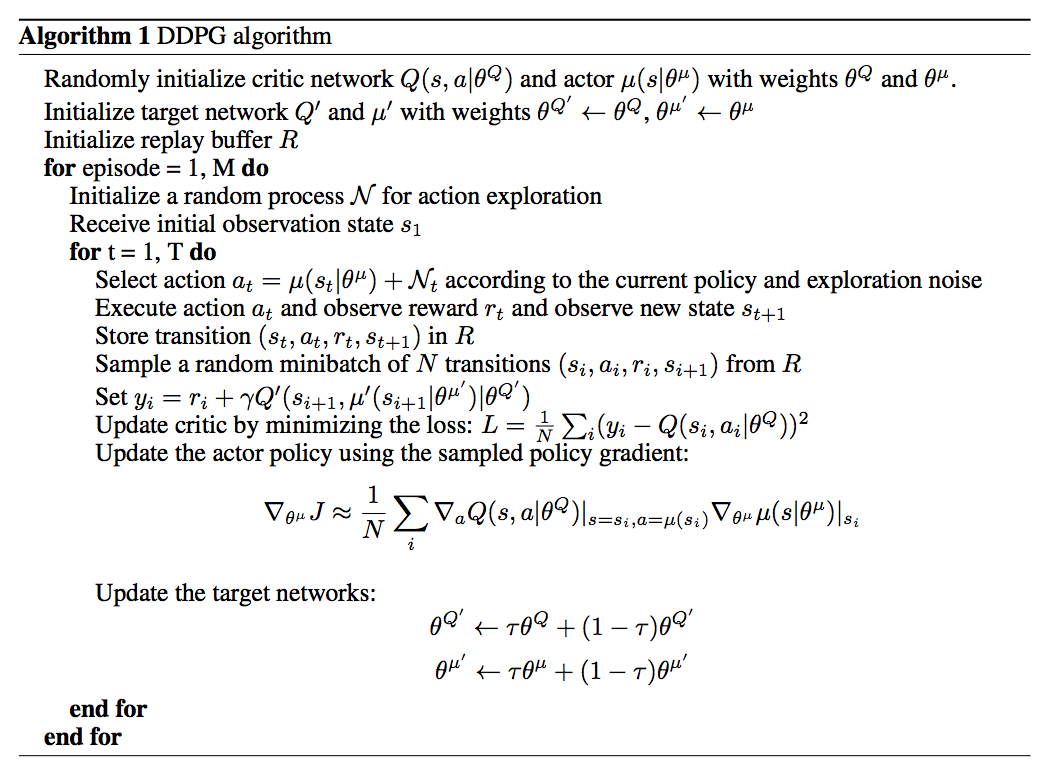深度增强学习--DDPG
2024-10-20 20:38:31
ddpg输出的不是行为的概率, 而是具体的行为, 用于连续动作 (continuous action) 的预测

代码实现的gym的pendulum游戏,这个游戏是连续动作的

"""
Deep Deterministic Policy Gradient (DDPG), Reinforcement Learning.
DDPG is Actor Critic based algorithm.
Pendulum example. View more on my tutorial page: https://morvanzhou.github.io/tutorials/ Using:
tensorflow 1.0
gym 0.8.0
""" import tensorflow as tf
import numpy as np
import gym
import time np.random.seed(1)
tf.set_random_seed(1) ##################### hyper parameters #################### MAX_EPISODES = 200
MAX_EP_STEPS = 200
lr_a = 0.001 # learning rate for actor
lr_c = 0.001 # learning rate for critic
gamma = 0.9 # reward discount
REPLACEMENT = [
dict(name='soft', tau=0.01),
dict(name='hard', rep_iter_a=600, rep_iter_c=500)
][0] # you can try different target replacement strategies
MEMORY_CAPACITY = 10000
BATCH_SIZE = 32 RENDER = True
OUTPUT_GRAPH = True
ENV_NAME = 'Pendulum-v0' ############################### Actor #################################### class Actor(object):
def __init__(self, sess, action_dim, action_bound, learning_rate, replacement):
self.sess = sess
self.a_dim = action_dim
self.action_bound = action_bound
self.lr = learning_rate
self.replacement = replacement
self.t_replace_counter = 0 with tf.variable_scope('Actor'):
# 这个网络用于及时更新参数
# input s, output a
self.a = self._build_net(S, scope='eval_net', trainable=True) ##这个网络不及时更新参数, 用于预测action
# input s_, output a, get a_ for critic
self.a_ = self._build_net(S_, scope='target_net', trainable=False) self.e_params = tf.get_collection(tf.GraphKeys.GLOBAL_VARIABLES, scope='Actor/eval_net')
self.t_params = tf.get_collection(tf.GraphKeys.GLOBAL_VARIABLES, scope='Actor/target_net') if self.replacement['name'] == 'hard':
self.t_replace_counter = 0
self.hard_replace = [tf.assign(t, e) for t, e in zip(self.t_params, self.e_params)]
else:
self.soft_replace = [tf.assign(t, (1 - self.replacement['tau']) * t + self.replacement['tau'] * e)
for t, e in zip(self.t_params, self.e_params)] def _build_net(self, s, scope, trainable):#根据state预测action的网络
with tf.variable_scope(scope):
init_w = tf.random_normal_initializer(0., 0.3)
init_b = tf.constant_initializer(0.1)
net = tf.layers.dense(s, 30, activation=tf.nn.relu,
kernel_initializer=init_w, bias_initializer=init_b, name='l1',
trainable=trainable)
with tf.variable_scope('a'):
actions = tf.layers.dense(net, self.a_dim, activation=tf.nn.tanh, kernel_initializer=init_w,
bias_initializer=init_b, name='a', trainable=trainable)
scaled_a = tf.multiply(actions, self.action_bound, name='scaled_a') # Scale output to -action_bound to action_bound
return scaled_a def learn(self, s): # batch update
self.sess.run(self.train_op, feed_dict={S: s}) if self.replacement['name'] == 'soft':
self.sess.run(self.soft_replace)
else:
if self.t_replace_counter % self.replacement['rep_iter_a'] == 0:
self.sess.run(self.hard_replace)
self.t_replace_counter += 1 def choose_action(self, s):
s = s[np.newaxis, :] # single state
return self.sess.run(self.a, feed_dict={S: s})[0] # single action def add_grad_to_graph(self, a_grads):
with tf.variable_scope('policy_grads'):
# ys = policy;
# xs = policy's parameters;
# a_grads = the gradients of the policy to get more Q
# tf.gradients will calculate dys/dxs with a initial gradients for ys, so this is dq/da * da/dparams
self.policy_grads = tf.gradients(ys=self.a, xs=self.e_params, grad_ys=a_grads) with tf.variable_scope('A_train'):
opt = tf.train.AdamOptimizer(-self.lr) # (- learning rate) for ascent policy
self.train_op = opt.apply_gradients(zip(self.policy_grads, self.e_params))#对eval_net的参数更新 ############################### Critic #################################### class Critic(object):
def __init__(self, sess, state_dim, action_dim, learning_rate, gamma, replacement, a, a_):
self.sess = sess
self.s_dim = state_dim
self.a_dim = action_dim
self.lr = learning_rate
self.gamma = gamma
self.replacement = replacement with tf.variable_scope('Critic'):
# Input (s, a), output q
self.a = tf.stop_gradient(a) # stop critic update flows to actor
# 这个网络用于及时更新参数
self.q = self._build_net(S, self.a, 'eval_net', trainable=True) # 这个网络不及时更新参数, 用于评价actor
# Input (s_, a_), output q_ for q_target
self.q_ = self._build_net(S_, a_, 'target_net', trainable=False) # target_q is based on a_ from Actor's target_net self.e_params = tf.get_collection(tf.GraphKeys.GLOBAL_VARIABLES, scope='Critic/eval_net')
self.t_params = tf.get_collection(tf.GraphKeys.GLOBAL_VARIABLES, scope='Critic/target_net') with tf.variable_scope('target_q'):
self.target_q = R + self.gamma * self.q_#target计算 with tf.variable_scope('TD_error'):
self.loss = tf.reduce_mean(tf.squared_difference(self.target_q, self.q))#计算loss with tf.variable_scope('C_train'):
self.train_op = tf.train.AdamOptimizer(self.lr).minimize(self.loss)#训练 with tf.variable_scope('a_grad'):
self.a_grads = tf.gradients(self.q, a)[0] # tensor of gradients of each sample (None, a_dim) if self.replacement['name'] == 'hard':
self.t_replace_counter = 0
self.hard_replacement = [tf.assign(t, e) for t, e in zip(self.t_params, self.e_params)]
else:
self.soft_replacement = [tf.assign(t, (1 - self.replacement['tau']) * t + self.replacement['tau'] * e)
for t, e in zip(self.t_params, self.e_params)] def _build_net(self, s, a, scope, trainable):#Q网络,计算Q(s,a)
with tf.variable_scope(scope):
init_w = tf.random_normal_initializer(0., 0.1)
init_b = tf.constant_initializer(0.1) with tf.variable_scope('l1'):
n_l1 = 30
w1_s = tf.get_variable('w1_s', [self.s_dim, n_l1], initializer=init_w, trainable=trainable)
w1_a = tf.get_variable('w1_a', [self.a_dim, n_l1], initializer=init_w, trainable=trainable)
b1 = tf.get_variable('b1', [1, n_l1], initializer=init_b, trainable=trainable)
net = tf.nn.relu(tf.matmul(s, w1_s) + tf.matmul(a, w1_a) + b1) with tf.variable_scope('q'):
q = tf.layers.dense(net, 1, kernel_initializer=init_w, bias_initializer=init_b, trainable=trainable) # Q(s,a)
return q def learn(self, s, a, r, s_):
self.sess.run(self.train_op, feed_dict={S: s, self.a: a, R: r, S_: s_})
if self.replacement['name'] == 'soft':
self.sess.run(self.soft_replacement)
else:
if self.t_replace_counter % self.replacement['rep_iter_c'] == 0:
self.sess.run(self.hard_replacement)
self.t_replace_counter += 1 ##################### Memory #################### class Memory(object):
def __init__(self, capacity, dims):
self.capacity = capacity
self.data = np.zeros((capacity, dims))
self.pointer = 0 def store_transition(self, s, a, r, s_):
transition = np.hstack((s, a, [r], s_))
index = self.pointer % self.capacity # replace the old memory with new memory
self.data[index, :] = transition
self.pointer += 1 def sample(self, n):
assert self.pointer >= self.capacity, 'Memory has not been fulfilled'
indices = np.random.choice(self.capacity, size=n)
return self.data[indices, :] import pdb; pdb.set_trace()
env = gym.make(ENV_NAME)
env = env.unwrapped
env.seed(1) state_dim = env.observation_space.shape[0]#
action_dim = env.action_space.shape[0]#1 连续动作,一维
action_bound = env.action_space.high#[2] # all placeholder for tf
with tf.name_scope('S'):
S = tf.placeholder(tf.float32, shape=[None, state_dim], name='s')
with tf.name_scope('R'):
R = tf.placeholder(tf.float32, [None, 1], name='r')
with tf.name_scope('S_'):
S_ = tf.placeholder(tf.float32, shape=[None, state_dim], name='s_') sess = tf.Session() # Create actor and critic.
# They are actually connected to each other, details can be seen in tensorboard or in this picture:
actor = Actor(sess, action_dim, action_bound, lr_a, REPLACEMENT)
critic = Critic(sess, state_dim, action_dim, lr_c, gamma, REPLACEMENT, actor.a, actor.a_)
actor.add_grad_to_graph(critic.a_grads)# # 将 critic 产出的 dQ/da 加入到 Actor 的 Graph 中去 sess.run(tf.global_variables_initializer()) M = Memory(MEMORY_CAPACITY, dims=2 * state_dim + action_dim + 1) if OUTPUT_GRAPH:
tf.summary.FileWriter("logs/", sess.graph) var = 3 # control exploration t1 = time.time()
for i in range(MAX_EPISODES):
s = env.reset()
ep_reward = 0 for j in range(MAX_EP_STEPS): if RENDER:
env.render() # Add exploration noise
a = actor.choose_action(s)
a = np.clip(np.random.normal(a, var), -2, 2) # add randomness to action selection for exploration
s_, r, done, info = env.step(a) M.store_transition(s, a, r / 10, s_) if M.pointer > MEMORY_CAPACITY:
var *= .9995 # decay the action randomness
b_M = M.sample(BATCH_SIZE)
b_s = b_M[:, :state_dim]
b_a = b_M[:, state_dim: state_dim + action_dim]
b_r = b_M[:, -state_dim - 1: -state_dim]
b_s_ = b_M[:, -state_dim:] critic.learn(b_s, b_a, b_r, b_s_)
actor.learn(b_s) s = s_
ep_reward += r if j == MAX_EP_STEPS-1:
print('Episode:', i, ' Reward: %i' % int(ep_reward), 'Explore: %.2f' % var, )
if ep_reward > -300:
RENDER = True
break print('Running time: ', time.time()-t1)
最新文章
- jquery 获取奇数索引的元素
- 《ASP.NET MVC 5框架揭秘》样章发布
- jquery tmpl 详解
- linux中解压缩并安装.tar.gz后缀的文件
- with as的用法
- BZOJ2721 [Violet 5]樱花
- JavaScript学习笔记(12)——JavaScript自定义对象
- 粵語/廣東話/Cantonese 資料/Material
- Web---演示Servlet的相关类、下载技术、线程问题、自定义404页面
- HDU-4089 Activation
- Myeclipse中java文件注释格式设置
- MagicalRecord(简化CoreData操作)
- 【Xamarin挖墙脚系列:Xamarin的终极破解步骤(更新)】
- java标签(label)求16进制字符串的整数和 把一个整数转为4个16进制字符表示
- windows下命令行cmder工具
- 浅谈C之精华---指针
- Python:基于MD5的文件监听程序
- jmeter4.0 执行jmeter_server.bat报错
- Dubbo学习笔记11:使用Dubbo中需要注意的一些事情
- 使用Intel IPT技术保护您的帐号安全